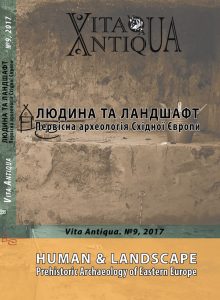VITA ANTIQUA ISSN: 2522-9419 (Online), ISSN: 2519-4542 (Print)
VITA ANTIQUA 9, 2017, HUMAN & LANDSCAPE: Prehistoric Archaeology of Eastern Europe, 117-126
Adaptation of Prehistoric Hunters to Life in Periglacial Plains (case of study: Upper Paleolithic sites of Bakshala River valley)
Pistruil I.V.¹
¹- Odesa Archaeological Museum of NAS Ukraine, Odesa
DOI:10.37098/VA-2017-9-117-126
https://doi.org/10.37098/VA-2017-9-117-126
ABSTRACT
There existed three main life support factors for Stone Age communities – water, food and raw material (for tool manufacture). The micro-region of Bakshala river downstream (the right-side tributary of Southern Boug river) corresponded to all these requirements. The work of expedition, headed by F. Kozubovskiy in 1930 – 1932, revealed first sites attributed to Stone Age near the village of Anetovka (Bakshala river basin). Complex and stationary (year-by-year) investigations of this micro-region (i.e. vicinities of villages Anetovka and Shchutske) were undertaken later on and were headed by V.N. Stanko in 1978 – 2007 and I.V. Pistruil since 2008. The “key-site” of this micro-region is Anetovka 2, which vicinities “contain” over 25 other localities, attributed to Upper Palaeolithic period – including surface collections of material and stationary excavated sites (Anetovka 1, Anetovka 13, Anetovka 22). Such archaeological concentration of Upper Palaeolithic sites within this micro-region was caused by rich flint sources, that were utilized independently and equally by ancient representatives of both technological traditions – Epi-Aurignacian and Epi-Gravettian.
Key words: prehistoric hunters, Upper Palaeolithic, cultural adaptation, Bakshala River valley, Eastern Europe
Language: Ukrainian
PDF:![]() DOWNLOAD
DOWNLOAD
UDK: [903:504.54](477.73)”632”


 The articles presented in this collection cover different aspects of trade connections of North Black Sea region in ancient and medieval time. The most of articles are dedicated to amphorae - basic trade packing, used in sea transportation.
The articles presented in this collection cover different aspects of trade connections of North Black Sea region in ancient and medieval time. The most of articles are dedicated to amphorae - basic trade packing, used in sea transportation.